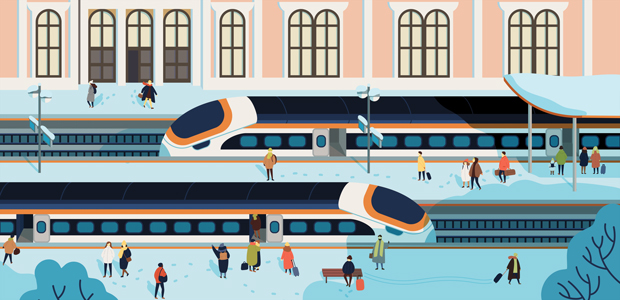
Real-time passenger data from St Pancras station
UK startup OpenSpace, whose digital twin platform measures real-time passenger movement, have discovered a new use for their technology in the fight against coronavirus. The pioneering system currently deployed at St Pancras station in London, can monitor social distancing through detecting and visualising the distance between passengers in real-time. It can also compare historical weekly and daily information for trend analysis.
With social distancing measures due to the coronavirus pandemic likely to continue for six months or longer, this data provides a useful indicator of public adherence to Government guidelines, especially when lockdown measures are lifted in stages. OpenSpace have been using Artificial Intelligence and Internet of Things (IoT) technology to detect and predict overcrowding at St Pancras since 2019 as part of a government-funded innovation project, and will be able to show how well the public respond to future changes to the lockdown.
OpenSpace CEO Nicolas LeGlatin explained: “Our technology is designed to detect real-time passenger separation to alert station managers to current and future overcrowding, and suggest interventions. But the unexpected events of the past few months have revealed a new application - monitoring social distancing. If our data can help better inform government strategy on COVID-19 to help save lives, then we want to do our bit.”
“The platform detected a 90% drop in passenger numbers after lockdown measures were introduced on Monday 23rd March, compared with a weekday in January this year. This represents the scale of travel demand change due to COVID-19 in one of the UK’s busiest stations.”
“Our purpose is to use technology to help make the passenger experience better for everyone, including protecting privacy. Cameras with computer vision technology are key to measuring passenger flow rate, travel patterns and social distancing. The data collected is anonymous, and doesn’t use facial recognition. Through the use of Virtual Reality (VR) headsets, operators can put themselves in the shoes of passengers in real-time. Like those approaching a crowded area, to see and feel some of what customers are feeling, driving improvement strategies.”
The project at St Pancras was funded by the Department for Transport through the First of a Kind Round 2 competition, delivered by InnovateUK. Other project partners include High Speed 1, Govia Thameslink Railway, Network Rail - High Speed, and Birmingham Centre for Railway Research and Education.

